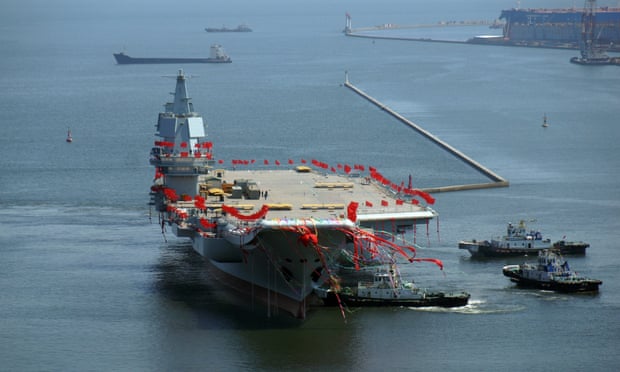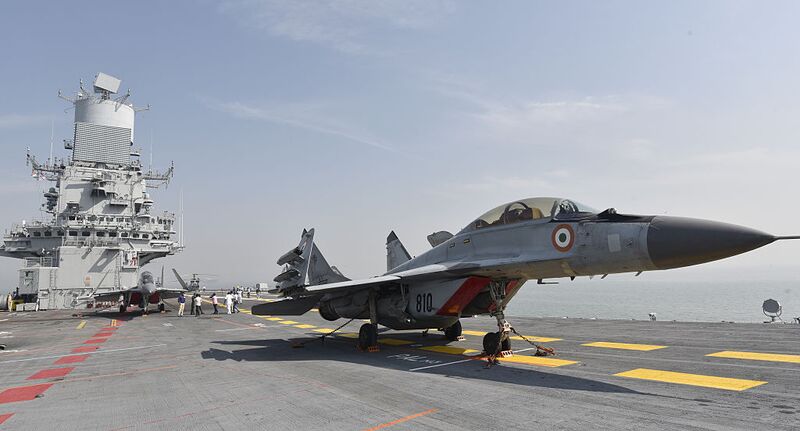China has launched its first domestically built aircraft carrier, which will join an existing one bought secondhand from Ukraine, amid rising tensions over North Korea and worries about Beijing’s assertiveness in the South China Sea.
The 50,000-ton carrier was towed from its dockyard just after 9 am on Wednesday after a ceremony in the northern port city of Dalian, where its predecessor, the Soviet-built Liaoning, also underwent extensive refurbishing before being commissioned in 2012, the Ministry of National Defence said.
Development of the new carrier began in 2013 and construction in late 2015. It is expected to be formally commissioned before 2020, after sea trials and the arrival of its full air complement.
Like the 60,000-ton Liaoning, the new carrier is based on the Soviet Kuznetsov class design, with a ski jump-style deck for taking off and a conventional oil-fuelled steam turbine power plant. That limits the weight of payloads its planes can carry, its speed and the amount of time it can spend at sea relative to American nuclear-powered carriers.
The main hull of the new carrier has been completed and its power supply put into place. Next up are mooring tests and the debugging of its electronic systems, the ministry said.
China is believed to be planning to build at least two and possibly up to four additional carriers, with one of them, the Type 002, reported to be under construction at a shipyard outside Shanghai. They are expected to be closer in size to the US navy’s nuclear-powered 100,000-ton Nimitz-class ships, with flat flight decks and catapults to allow planes to launch with more bombs and fuel aboard.
Along with their role in protecting China’s maritime interests, Chinese naval strategists see the carrier programme as being “about having naval power commensurate with China’s international status, to impress both external and domestic audiences,” said Michael Chase, an expert on the Chinese military at US thinktank the Rand Corporation.
“[The new carrier] is likely to be seen as further evidence of China’s desire to become the most powerful and influential country in the region,” Chase said. That would be especially worrying to Indian security analysts who were already concerned about Beijing’s ambitions in the Indian Ocean, he said.
India, along with Japan and Taiwan, which also viewed Chinese carriers as threats, would probably respond by building additional submarines and anti-ship missiles, said Ian Easton, a research fellow at the Project 2049 Institute in Arlington, Virginia.
“[China’s] expansionist behaviour in the South China Sea and its aggressive efforts to undermine the security of Taiwan and Japan, in particular, have translated into a situation where few countries now trust that Beijing has benign motives,” he said.
China claims Taiwan as its territory to be brought under control by force if necessary, and was seen as displaying that threat when it sailed the Liaoning through the Taiwan Strait earlier this year.
The new carrier is part of an ambitious expansion of the Chinese navy, which is projected to have between 265 and 273 warships, submarines and logistics vessels by 2020, according to the Washington DC-based Center for Naval Analyses. That compares with 275 deployable battle force ships presently in the US navy, China’s primary rival in the Asia Pacific.
The US operates 10 aircraft carriers, has 62 destroyers to China’s 32, and 75 submarines to China’s 68. The US navy has 323,000 personnel to China’s 235,000.
China has offered little information about the roles it expects its carriers to play, although its planning appears to be evolving as it gains more experience.
The Liaoning was initially touted mainly as an experimental and training platform, but in December was declared to be combat-ready and has taken part in live-firing exercises in the South China Sea, where tensions have risen over China’s construction of manmade islands complete with airstrips and military structures.
China’s Aircraft Carrier Future
China is thought to have already begun construction on its second domestic carrier – Type-002 — at the Jiangnan Changxingdao shipyard near Shanghai.
Unlike the new Type-001A and Liaoning, the new carrier is expected to field a catapult launching system allowing a wider variety of aircraft to operate from the carrier. Satellite images of the nearby Huangdicun Airbase in Liaoning Province show what appears to be electromagnetic and steam catapult launching test systems.
“Developing its own CATOBAR system, and fitting it on China’s future aircraft carriers will enable the PLAN to operate a well-rounded carrier air wing that includes force multipliers such as Airborne Early Warning and Control aircraft, which tend to be heavier and use less-powerful, but more efficient engines,” wrote USNI News contributor Mike Yeo in September.
Still, what China intends to do with the carriers is less than clear.
“China wants to sail a gradually increasing number of aircraft carriers into the center of growing blue water operations. The evidence is growing in Chinese shipyards and ports across the Indian Ocean and beyond,” Andrew Erickson, an associate professor at the U.S. Naval War College’s China Maritime Studies Institute (CMSI) and author of a recent book on Chinese naval shipbuilding, told USNI News on Wednesday.
Beijing has flirted with transparency in expressing its aircraft carrier goals. Government documents and officials have said China was set to pursue a four-carrier force over the last eight years.
Buried in its 2010 Ocean Development Report, China declared it would pursue development of its own domestic carrier program. It took six months for the detail to make it into the Western press.
“In 2009, China put forward an idea and plan for building aircraft carriers. These indicate China has entered the historical era of building a maritime superpower,” read a translation of the report.
Three years ago, a Chinese party official declared Beijing was set to build four carriers in a state report, but the government quickly deleted the instance.
A four-carrier force would mimic traditional carrier deployment patterns in which there are three carriers in maintenance or workups for every carrier deployed.
“This is likely just the beginning of China’s fledgling naval aviation capabilities as their maritime forces build towards a large well-balanced fleet capable of protecting and projecting Chinese interests in the Pacific and potentially around the world,” Eric Wertheim, author of U.S. Naval Institute’s Combat Fleets, told USNI News on Wednesday.
The ceremony was kicked off in magnificent national anthem at 9:00 and a bottle of champagne was broken on the aircraft carrier as a customary way of blessing the ship. After that, the new aircraft carrier was slowly towed out of the dockyard and transferred to the wharf.
The second aircraft carrier is domestically built by China. China started building it in November, 2013. At present, the main hull of this aircraft carrier has been completed and the main system devices including power supply have been installed in place.
Undocking and launching is one of the important nodes of a new aircraft carrier construction, marking that China has made significant phased achievements in designing and building an aircraft carrier independently. Next, the aircraft carrier will debug its system devices and conduct fitting-out as planned, and start mooring tests in an all-round way.
The PLA Navy Commander Shen Jinlong,PLA Navy Political Commissar Miao Hua, and CSIC President Hu Wenming also attended the ceremony.








No comments: